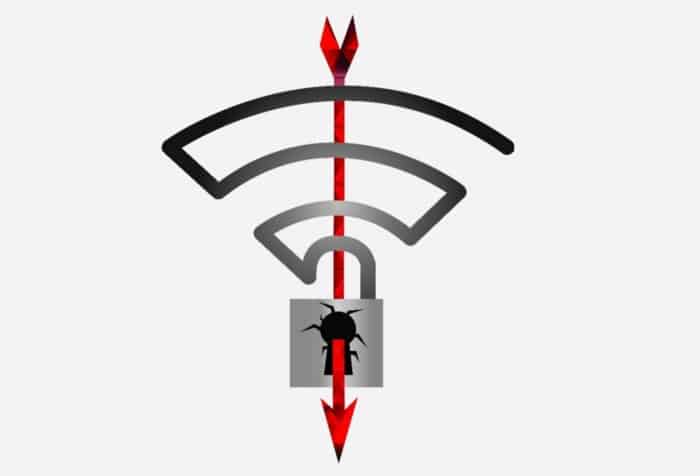KRACK attack is especially bad news for Android and Linux users.
Researchers have disclosed a serious weakness in the WPA2 protocol that allows attackers within range of vulnerable device or access point to intercept passwords, e-mails, and other data presumed to be encrypted, and in some cases, to inject ransomware or other malicious content into a website a client is visiting.
The proof-of-concept exploit is called KRACK, short for Key Reinstallation Attacks. The research has been a closely guarded secret for weeks ahead of a coordinated disclosure that was scheduled for 8am Monday, East Coast time. A website disclosing the vulnerability said it affects the core WPA2 protocol itself and is effective against devices running Android, Linux, and OpenBSD, and to a lesser extent macOS and Windows, as well as MediaTek Linksys, and other types of devices. The site warned that attackers can exploit the flaw to decrypt a wealth of sensitive data that’s normally encrypted by the nearly ubiquitous Wi-Fi encryption protocol.
“This can be abused to steal sensitive information such as credit card numbers, passwords, chat messages, emails, photos, and so on,” researcher Mathy Vanhoef, of the Katholieke Universiteit Leuven in Belgium wrote. “The attack works against all modern protected Wi-Fi networks. Depending on the network configuration, it is also possible to inject and manipulate data. For example, an attacker might be able to inject ransomware or other malware into websites.”
Vanhoef provided the following video showing the attack against a device running Google’s Android mobile operating system:
It shows the attacker decrypting all data the phone sends to the access point. The attack works by forcing the phone into reinstalling an all-zero encryption key, rather than the real key. This ability, which also works on Linux, makes the attack particularly effective on these platforms.
The site went on to warn that visiting only HTTPS-protected Web pages wasn’t automatically a remedy against the attack, since many improperly configured sites can be forced into dropping encrypted HTTPS traffic and instead transmitting unencrypted HTTP data. In the video demonstration, the attacker uses a script known as SSLstrip to force the site match.com to downgrade a connection to HTTP. The attacker is then able to steal an account password when the Android device logs in.
“Although websites or apps may use HTTPS as an additional layer of protection, we warn that this extra protection can (still) be bypassed in a worrying number of situations,” the researchers explained. “For example, HTTPS was previously bypassed in non-browser software, in Apple’s iOS and OS X, in Android apps, in Android apps again, in banking apps, and even in VPN apps.”
The researcher went on to say that the weakness allows attackers to target both vulnerable access points as well as vulnerable computers, smartphones and other types of connecting clients, albeit with differing levels of difficulty and effectiveness. Neither Windows nor iOS are believed to be vulnerable to the most severe attacks. Linux and Android appear to be more susceptible, because attackers can force network decryption on clients in seconds with little effort.
Vanhoef said clients can be patched to prevent attacks even when connected to vulnerable access points. Linux patches have been developed, but it’s not immediately clear when they will become available for various distributions and for Android users. Patches are also available for some but not all Wi-Fi access points.
In response to a FAQ item asking if the vulnerability signaled the need for a WPA3 standard, Vanhoef wrote:
No, luckily [WPA2] implementations can be patched in a backwards-compatible manner. This means a patched client can still communicate with an unpatched access point, and vice versa. In other words, a patched client or access points sends exactly the same handshake messages as before, and at exactly the same moments in time. However, the security updates will assure a key is only installed once, preventing our attacks. So again, update all your devices once security updates are available.
KRACK works by targeting the four-way handshake that’s executed when a client joins a WPA2-protected Wi-Fi network. Among other things, the handshake helps to confirm that both the client and access points have the correct credentials. KRACK tricks the vulnerable client into reinstalling an already-in-use key. The reinstallation forces the client to reset packet numbers containing a cryptographic nonce and other parameters to their initial values. KRACK forces the nonce reuse in a way that allows the encryption to be bypassed. Ars Technica IT editor Sean Gallagher has much more about KRACK here.
Monday’s disclosure follows an advisory the US CERT recently distributed to about 100 organizations described the research this way:
US-CERT has become aware of several key management vulnerabilities in the 4-way handshake of the Wi-Fi Protected Access II (WPA2) security protocol. The impact of exploiting these vulnerabilities includes decryption, packet replay, TCP connection hijacking, HTTP content injection, and others. Note that as protocol-level issues, most or all correct implementations of the standard will be affected. The CERT/CC and the reporting researcher KU Leuven, will be publicly disclosing these vulnerabilities on 16 October 2017.
According to a researcher who has been briefed on the vulnerability, it works by exploiting a four-way handshake that’s used to establish a key for encrypting traffic. During the third step, the key can be resent multiple times. When it’s resent in certain ways, a cryptographic nonce can be reused in a way that completely undermines the encryption.
Although kept secret for weeks, KRACK came to light on Sunday when people discovered a Github page belonging to one of the researchers and a separate krackattacks.com website disclosing the vulnerability used the following tags:
- WPA2
- KRACK
- key reinstallation
- security protocols
- network security, attacks
- nonce reuse
- handshake
- packet number
- initialization vector
Researchers briefed on the vulnerabilities said they are indexed as: CVE-2017-13077, CVE-2017-13078, CVE-2017-13079, CVE-2017-13080, CVE-2017-13081, CVE-2017-13082, CVE-2017-13084, CVE-2017-13086, CVE-2017-13087, CVE-2017-13088. One researcher told Ars that Aruba and Ubiquiti, which sell wireless access points to large corporations and government organizations, already have updates available to patch or mitigate the vulnerabilities.
The vulnerabilities are scheduled to be formally presented in a talk titled Key Reinstallation Attacks: Forcing Nonce Reuse in WPA2 scheduled for November 1 at the ACM Conference on Computer and Communications Security in Dallas. It’s believed that Monday’s disclosure will be made through the site krackattacks.com. The researchers presenting the talk are Mathy Vanhoef and Frank Piessens of KU Leuven. The researchers presented this related research in August at the Black Hat Security Conference in Las Vegas.
The vulnerability is likely to pose the biggest threat to large corporate and government Wi-Fi networks, particularly if they accept connections from Linux and Android devices. And once again, attackers must be within Wi-Fi range of a vulnerable access point or client to pull off the attacks. Home Wi-Fi users are vulnerable, too, again especially if they connect with Linux or Android devices, but there are likely easier ways they can be attacked. Researcher and Errata Security CEO Rob Graham has useful information and analysis here.
Microsoft on Monday posted an advisory here that explains the conditions that are necessary for attackers to exploit vulnerable Windows machines. The company issued an update during last week’s Patch Tuesday release that fixes the problem. Windows users who have yet to install the patch should do so right away. Microsoft’s advisory said even when patched, affected Windows system may offload vulnerable WPA2 functionality to installed Wi-Fi hardware when devices enter low-power standby modes. To fully protect themselves, users should also install new Wi-Fi device drivers if available, in addition to the Windows fix.
If possible, people with vulnerable access points and clients should avoid using Wi-Fi until patches are available and instead use wired connections. When Wi-Fi is the only connection option, people should use HTTPS, STARTTLS, Secure Shell, and other reliable protocols to encrypt Web and e-mail traffic as it passes between computers and access points. As a fall-back users should consider using a virtual private network as an added safety measure, but users are reminded to choose their VPN providers carefully, since many services can’t be trusted to make users more secure.
Post your thoughts below in the comment section.
SOURCE: Arstechnica
![]()





